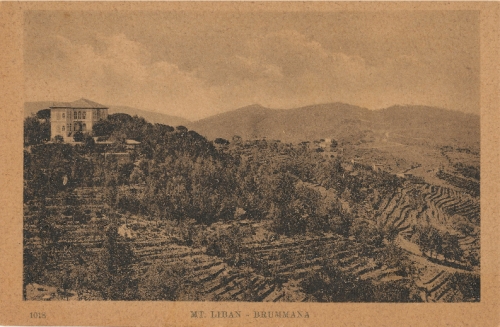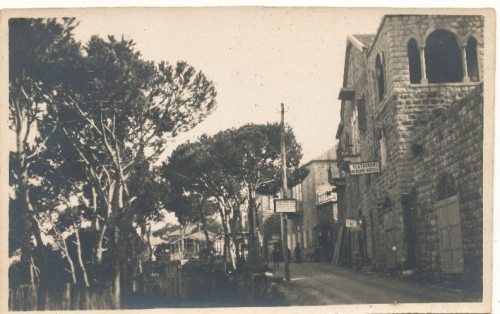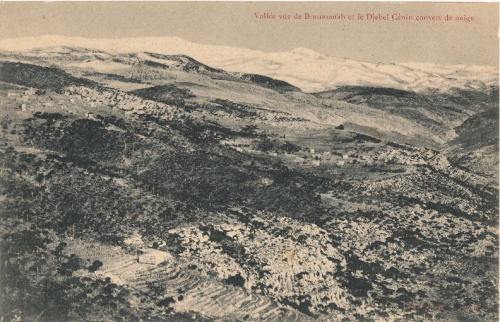Brummana
♦
Charles Little
Brummana
(1930s)
etching
28.5 x 19.9 cm (plate); 29.2 x 20.5 cm (sheet)
Private collection, Australia
♦
Charles Little (attributed to)
Beirut and the mountains
(1940s)
gelatin silver print
5.6 x 8.4 cm (image); 6.2 x 8.8 cm (sheet)
Private collection, Australia
The village of Brummana lies about seventeen kilometres east of the Lebanese capital Beirut, atop one of the Metn Hills within the mountain range known as Mount Lebanon. At some seven-hundred and fifty metres above sea level the village overlooks the coast of the Mediterranean Sea and enjoys picturesque views of several adjacent valleys and mountains. For many years, Lebanon’s famous Cedars have grow tall in these mountains and with arrival of winter snow, Brummana’s beauty becomes breathtaking.
Unknown photographer, Lebanon
Wega Saalmüller Little and unknown man beneath tree at The Cedars, Lebanon
(1920s)
gelatin silver print
8.1 x 5.4 cm (image); 8.8 x 6.0 cm (sheet)
Private collection, Australia
♦
Charles Little (attributed to)
Landscape, Brummana, Lebanon
(early 1900s)
gelatin silver print
13.5 x 8.1 cm (image); 14.4 x 8.8 cm (sheet)
Private collection, Australia
Unknown photographer, Lebanon
South side of canyon between Brummana and Ras-el-Metn, postcard
(early 1900s)
gelatin silver print
12.7 x 7.7 cm (image); 13.7 x 8.7 cm (sheet)
Private collection, Australia
Sarrafian Bros., Beirut
Mt Liban, Brummana
(early 1900s)
gelatin silver print
8.1 x 12.8 cm (image); 9.2 x 14.1 cm (sheet)
Private collection, Australia
Brummana is one of many villages dotted among the famous Cedars of Mount Lebanon. Mulberry trees however were also very important to the region. From as early as the seventh century the silk industry formed part of the local economy. For more information about the significance of the silk industry on Mount Lebanon watch http://www.bbc.com/news/world-29719542 and visit http://www.thesilkmuseum.com/Homepage/Homepage_en.html
Unknown photographer, Lebanon
Ladies in a silk workshop, Lebanon
(1890s–1910s)
albumen print
10.8 x 15.1 cm (image and sheet)
Private collection, Australia
Charles Little (attributed to)
Shops, Brummana, Lebanon
(early 1900s)
gelatin silver print
8.2 x 13.3 cm (image); 8.7 x 13.9 cm (sheet)
Private collection, Australia
♦
Although terribly damaged by heat and light, this panoramic photograph depicts the buildings that grew up within the village in connection with the Quaker Mission settlement of the late 1880s. Brummana comprised buildings, houses and shops, many dating from before the arrival of the Quaker community. However, as the Mission developed the village gained many sturdy stone structures including boys and girl’s schools, a meeting hall, a hospital, student boarding houses, residential accommodation and an hotel.
Maison Bonfils, Beirut (attributed to)
Panorama of Quaker Misson and village of Brummana, Lebanon
(1890s)
albumen print
9.1 x 35.8 cm (image and sheet)
Private collection, Australia
Theophilus Waldmeier, assisted by his wife Susan and eldest daughter Rosa, was the driving force behind the Mission. A smaller view of this landscape, seen from a slightly different vantage, was illustrated in his autobiography of 1886 (see his Wikipedia page). It is likely that the photographer of this panorama was aware of the earlier illustration as Adrien Bonfils, of Maison Bonfils, married Theophilus’s niece, Marielie Saalmüller, in 1897.
The discolouration and fading have lent an unfortunate, and slightly apocalyptic, air to this photograph that belies the fact that the fledgling community depicted continues to thrive today. Brummana High School has become one of the most respected educators in the Middle East and the town has made a success of marketing its natural beauty to local and international tourists.

Maison Bonfils, Beirut
Chêne sèculaire (Ancient Oak), Broumanah, postcard
(early 1900s)
gelatin silver print
14.0 x 9.0 cm (image and sheet)
Private collection, Australia
Maison Bonfils, Beirut
Valley view of Brummana in winter, postcard
(early 1900s)
gelatin silver print
9.0 x 14.0 cm (image and sheet)
Private collection, Australia
♦

Republic of Lebanon
Cedarhurst Hotel and grounds, Brummana, Lebanon, map
1942
photostat
29.9 x 25.8 (image); 32.8 x 27.6 cm irreg. (sheet)
Private collection, Melbourne
The Hotel Libanon was established by Susan Waldmeier’s sister, Mary, and brother-in-law Karl. Karl Saalmüller and Theophilus Waldmeier had lived and worked together for many years. They originally left Europe in 1858 as part of the St Chrischona-Pilgermission to Ethiopia. A decade later, following the Battle of Magdala and suicide of Emperor Tewodros, the pair left Ethiopia with their wives and children for Jerusalem. The Saalmüller’s remained in the Holy Land until 1877 when they decided to join their relatives, the Waldmeier’s, in making Brummana their home.
Although the hotel remained in the Saalmüller family, and on the same site, until the 1950s, photographs show that Hotel Libanon changed its name at least twice: once to Les Cedrés and later to Cedarhurst. It seems likely that these revisions roughly coincided with the deaths of Karl Saalmüller and Mary Bell Saalmüller. When Karl died in 1906, his wife Mary became proprietor and when she died in 1936, their daughter Wega Little took over.
Maison Bonfils, Beirut
Hôtel Libanon Saalmüller, Broumanah, postcard
(early 1900s)
gelatin silver print
9.0 x 14.0 cm (image and sheet)
Private collection, Australia
Maison Bonfils, Beirut (attributed to)
Les Cedres Hotel, Brummana, postcard
(1910s–20s)
gelatin silver print
8.9 x 14.1 cm (image and sheet)
Private collection, Australia

Charles Little (attributed to)
Northern side of Cedarhurst Hotel, Brummana in winter, postcard
(1930s–50s)
gelatin silver print
13.0 x 8.0 cm (image); 14.0 x 9.0 cm (sheet) (illustrated cropped)
Private collection, Australia
by Pat Little
2012
♦
Copyright ownership of all page and post entries is retained by the author













I have been looking around on the internet to get an idea of what the area looks like now and have found the following:
Brummana High School – principal’s house and tennis courts:
http://www.habeeb.com/lebanon.photos.47.html
Thank-you for the link to the beautiful photos of modern-day Brummana
[…] Brummana […]